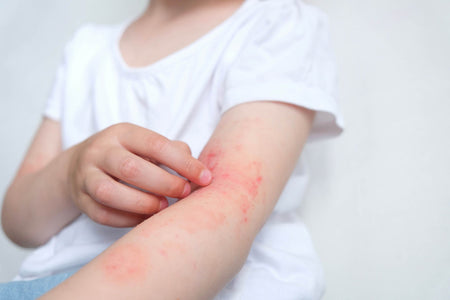- Many adults can suddenly develop allergies, even if they didn’t have them as children.
- Common symptoms of adult-onset allergies include sneezing, runny nose, itchy eyes, and respiratory issues.
- Managing adult-onset allergies may involve medications, tracking allergens, improving indoor air quality, and making lifestyle adjustments to minimize exposure.
Allergies are often thought of as something kids deal with, with nearly 1 in 5 children experiencing a seasonal allergy [*]. While many kids outgrow their allergies, the situation can get trickier as they grow up.
When people become adults, they might find themselves dealing with new triggers or worse reactions to things they were fine with before. Factors like changing environments, lifestyle habits, and even stress can all play a role in developing allergies later in life.
How are Allergies Developed?
Allergies develop when the immune system mistakenly identifies a harmless substance, such as pollen, pet dander, or dust mites, as a threat. In response, the body produces antibodies called Immunoglobulin E (IgE) that trigger the release of chemicals like histamine. This causes the symptoms associated with allergic reactions, such as sneezing, itching, or swelling.
The exact cause of why some people develop allergies is not fully understood. However, several key factors are believed to contribute to the development of allergic reactions. These may include genetics, environmental exposure, and changes in the immune system.
Related: Types of Allergies
Can You Develop Allergies Later in Life?
Yes, it is possible to suddenly develop allergies later in life, a condition called adult-onset allergies . A person may become sensitized to an allergen over time, meaning repeated exposure can eventually lead to an allergic reaction.
For instance, after moving to a different area your body can become sensitized to the new allergens after several years. It’s important to note that while this may come as a surprise, allergies can start at any age, not just during childhood.
Related: Are Allergies Hereditary?
How Common are Adult-Onset Allergies?
Adult-onset allergies are quite common, with many individuals experiencing them for the first time in their 30s, 40s, or later. According to a 2021 report from the CDC, approximately 31.8% of adults had a diagnosed seasonal allergy, eczema, or food allergy [*].
The CDC data also revealed that women were more likely than men to have seasonal allergies (29.9% vs 21.1%) [*].
Although allergies are often associated with childhood, they can affect adults just as frequently.
Symptoms of Adult-Onset Allergies
Symptoms of adult-onset allergies can vary depending on the type of allergen but often include:
- Sneezing
- Runny or stuffy nose
- Itchy or watery eyes
- Coughing
- Wheezing
- Shortness of breath
- Rashes
- Hives
- Itching
If someone experiences severe symptoms, such as difficulty breathing or swelling of the throat, it may indicate anaphylaxis, which is a medical emergency requiring immediate attention.
Diagnosing Adult-Onset Allergies
Diagnosing adult-onset allergies typically starts with a discussion of your symptoms and medical history. A doctor may ask about when and how often your symptoms occur, as well as possible triggers like certain foods, pets, or environmental changes.
To confirm the diagnosis, they may recommend allergy tests such as a skin prick test, where small amounts of allergens are applied to the skin to see if a reaction occurs.
Blood tests, which measure specific allergy-related antibodies, are another option. Keeping track of your symptoms and potential triggers can also help doctors identify the cause of your allergies.
Treating Adult-Onset Allergies
Adult-onset allergies can be effectively treated, and medications play an important role in their management. While some individuals may develop allergies later in life, the same treatment principles apply to those with childhood allergies.
Here’s how medications can help:
Antihistamines
Antihistamines are commonly used to relieve allergy symptoms like sneezing, runny nose, and itchy eyes. They work by blocking the action of histamine, a chemical released during an allergic reaction.
Antihistamines can be categorized into two main types: sedating (drowsy) and non-sedating (non-drowsy). Non-sedating antihistamines include loratadine (Claritin) and cetirizine (Zyrtec). These medications are more suitable for daytime use.
Related: Allegra vs. Zyrtec: Differences and Alternatives
Nasal Sprays
Nasal sprays, particularly corticosteroids, are effective for treating nasal congestion and inflammation caused by allergies. These sprays reduce swelling in the nasal passages and decrease mucus production.
Common options include fluticasone (Flonase) and budesonide (Rhinocort). They are often recommended for long-term management and can provide significant relief from nasal allergy symptoms [*][*].
On the other hand, combination nasal sprays are an important advancement in allergy treatment, as they combine multiple active ingredients into one formula to address different symptoms at the same time.
Allermi nasal spray, for instance, includes up to 4 ingredients, such as an anti-inflammatory corticosteroid, decongestant, and antihistamine.
Immunotherapy
Immunotherapy is a long-term treatment option that involves gradually desensitizing the immune system to specific allergens. It can reduce the severity of allergic reactions and may even provide lasting relief after treatment ends.
There are two main methods of immunotherapy: allergy shots and sublingual tablets. Allergy shots involve receiving injections over time with increasing doses of allergens. In contrast, sublingual tablets are placed under the tongue for the body to absorb.
Managing Adult-Onset Allergies
In addition to proper treatments, effectively managing sudden allergies later in life involves lifestyle adjustments. Here are some tips:
- Keep track of allergens and minimize exposure. Consider undergoing allergy testing to pinpoint specific allergens, such as pollen, dust mites, mold, or pet dander.
- Use HEPA vacuum cleaners and wash bedding regularly.
- Keep windows closed in the bedroom to prevent pollens from getting on bedding.
- Improve indoor air quality with HEPA filters. Place HEPA air purifiers in the bedroom as well as common living spaces, such as the living room or family room, to capture airborne allergens.
- Shower and change clothes after being outdoors.
- Stay indoors during high pollen counts or poor air quality. Download weather apps that provide real-time pollen forecasts and air quality indexes. Set alerts for high pollen counts to help you plan your activities.
- Drink plenty of water to help clear mucus. When mucus is thin, it’s easier for the body to expel, which reduces congestion and promotes clearer airways.
The Bottom Line
As adults are exposed to new allergens like pet dander, pollen, and dust mites, they may develop symptoms they didn’t experience before. Adult-onset allergies can result from various factors.
It's important to identify your allergy triggers and consult a professional for testing. With the right treatment — such as antihistamines or combination nasal sprays — and some adjustments to your routine, you can effectively manage your allergies.
References:
- More Than a Quarter of U.S. Adults and Children Have at Least One Allergy. (n.d.). https://www.cdc.gov/nchs/pressroom/nchs_press_releases/2022/20220126.htm
- Centers for Disease Control and Prevention. (2021). Prevalence of Allergic Conditions Among Adults: United States, 2018-2019 (NCHS Data Brief No. 460). https://www.cdc.gov/nchs/products/databriefs/db460.htm
- Fluticasone Nasal Spray. (2024, May 1). Cleveland Clinic. https://my.clevelandclinic.org/health/drugs/18853-fluticasone-nasal-spray
- Kalola, U. K., & Ambati, S. (2023, August 28). Budesonide. StatPearls - NCBI Bookshelf. https://www.ncbi.nlm.nih.gov/books/NBK563201/









